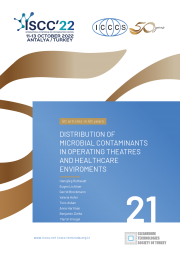DISTRIBUTION OF MICROBIAL CONTAMINANTS IN OPERATING THEATRES AND HEALTHCARE ENVIRONMENTS
Authors:
Hansjörg Rotheudt, Eugen Lichtner, Gerrid Brockmann, Valeria Hofer, Tunc Askan, Anne Hartmann, Benjamin Zielke, Martin KriegelKeywords:
Microbial Contamination, Particle Distribution, Deposition of Airborne Bacteria, Particle Modelling, Operating Rooms, Airborne, Healthcare, Contamination, Design, IsothermalAbstract:
Contamination control in healthcare facilities against airborne pathogens is a challenging task to prevent nosocomial infections and the distribution of highly infectious diseases from one patient to another. In different areas and contamination protected areas like operating rooms, isolation wards and intensive care units, similar tasks for the ventilation scheme and knowledge about the distribution of pathogens in the airflow is needed. Most investigations and the standard test cases for acceptance tests consider particulate contaminants of small particle size that is completely airborne without gravitational effects. Most microbial contaminants like respiratory droplets and skin flakes have particle diameters of 1 to 20 μm. These particles are also affected by their gravitational settling and do not perfectly follow the airflow motion. The gravitational forces lead to significant increase of their deposition behaviour. Investigations that consider the microbial particulates as completely airborne have limited validity to predict the surface contamination inside the patient’s wound field or on medical instruments and equipment. However, accurate prediction of the behaviour of the contaminants is fundamental for risk assessment and performance tests of ventilation systems. Numerical simulation models to calculate the particle motion and interaction to the airflow field provide more detailed information about the paths for contamination and infectious diseases. To develop and evaluate contamination control strategies for healthcare environments, the method to simulate the movement of pathogen contaminants has major importance. A CFD simulation is a resource-efficient approach. It provides valuable insights into the three-dimensional and transient behaviour of contaminants. Accumulation zones of contaminants in the air and deposition spots on surfaces can be located and the optimal positions of monitoring devices can be found. The state-of-the-art approaches in particle modelling and simulation as well as their advantages and limitations are presented. Within several research projects in the field of cleanrooms, health care facilities and contamination control, the exposure, distribution, deposition and resuspension of airborne particles ranging from 0.1 to 20 µm are investigated at the Hermann-Rietschel-Institut (HRI). In this range of diameter, the transition zone between airborne particles and particles which are highly affected by gravitation is particularly challenging.Article:
.
 Click to Download PDF
Click to Download PDF
